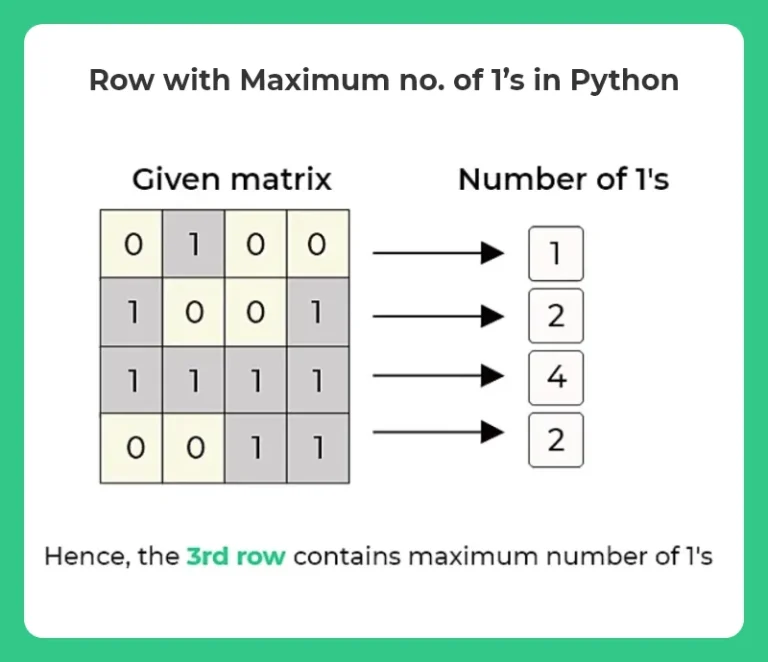Find Row with Maximum no. of 1’s in Python
Row with Maximum no. of 1’s in Python
Here on this page, we will learn how to Find a Row with Maximum no. of 1’s in Python Language.
Example :
- Input : matrix = [ [ 0, 1, 0, 0 ],
[ 1, 0, 0, 1 ],
[ 1, 1, 1, 1 ],
[ 0, 0, 1, 1 ] ] - Output : 3rd Row

Method Discussed :
- Method 1 : Naïve Method
- Method 2 : Using Binary Search.
Algorithm ( Method 1 )
- In this method we will traverse each row of the matrix,
- Find the count of 1’s in each row.
- Then compare it with max_count and the index value.
- After complete iteration, print the value of the index.
Time and Space Complexity :
- Time-Complexity : O(r*c)
- Space-Complexity : O(1)

Python Code
Run
Matrix = [[0, 0, 0, 1],
[0, 1, 1, 1],
[1, 1, 1, 1],
[0, 0, 0, 0]]
max_count, row = 0, -1
for i in range(4):
count = 0
for j in range(4):
if Matrix[i][j] == 1:
count += 1
if count > max_count:
max_count = count
row = i
print("Row with maximum 1's is :", row+1)
Output
Row with maximum 1's is : 3
Algorithm ( Method 2 )
- Take a variable to hold the index value of required row, let it be index=-1, and max_count=0, that hold the maximum count of 1.
- Now, iterate over each row, and take variable say count=0, to count the number of 1’s in current row.
- For, i-th row, use binary search to find the first instance of 1.
- Then count = No. of columns – first instance of 1.
- Check if count > max_count, then set max_count = count and index=i.
- After the iteration of all rows, print the value of the index.
Time and Space Complexity :
- Time-Complexity : O(r*log(c))
- Space-Complexity : O(1)
Run
def first(arr, low, high):
if high >= low:
mid = low + (high - low) // 2
if (mid == 0 or arr[mid - 1] == 0) and arr[mid] == 1:
return mid
elif arr[mid] == 0:
return first(arr, (mid + 1), high)
else:
return first(arr, low, (mid - 1))
return -1
Matrix = [[0, 0, 0, 1],
[0, 1, 1, 1],
[1, 1, 1, 1],
[0, 0, 0, 0]]
max_count, row = 0, -1
for i in range(4):
count = 0
x = first(Matrix[i], 0, 3)
if x != -1:
count = 4 - x
if count > max_count:
max_count = count
row = i
print("Row with maximum 1's is :", row + 1)
Output
Row with maximum 1's is : 3
For similar questions click on the given button






n=4
a = [ [ 0, 1, 0, 0 ],
[ 1, 0, 0, 1 ],
[ 1, 1, 1, 1 ],
[ 0, 0, 1, 1 ] ]
max=0
for i in range(n):
num=0
for j in range(n):
if a[i][j]==1:
num=num+1
if num>max:
max=num
index=i
print(index+1)
row, col = [int(x) for x in input().split()]
mat = []
for i in range(0, row):
m = []
for j in range(0, col):
m.append(int(input()))
mat.append(m)
ones = []
count1 = 0
for j in range(1, len(mat[0])+1):
ones.append(str(j))
count1 += mat[j-1].count(1)
ones.append(count1)
count1 = 0
rowdict = {ones[i]: ones[i + 1] for i in range(0, len(ones), 2)}
print(“The rows which have the maximum nos of 1’s are: “)
maxi = max(rowdict.values())
for k in rowdict.keys():
if rowdict[k] == maxi:
print(k, end = ” “)